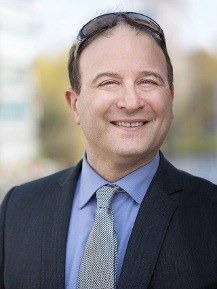Taffy Brodesser-Akner in The New York Times:
 Jonathan Franzen now lives in a humble, perfectly nice two-story house in Santa Cruz, Calif., on a street that looks exactly like a lot of other streets in America and that, save for a few cosmetic choices, looks exactly like every other house on the block. Santa Cruz, he says, is a “little pocket of the ’70s that persisted.” Inside his house, there is art of birds — paintings and drawings and figurines. Outside, in the back, there are actual birds, and a small patio, with a four-person wrought-iron dining set, and beyond that, a shock: a vast, deep ravine, which you would never guess existed behind the homes on such a same-looking street, but there it is. There is so much depth and flora to it, so much nature, so many birds — whose species Franzen names as they whiz by our faces — that you almost don’t notice the ocean beyond.
Jonathan Franzen now lives in a humble, perfectly nice two-story house in Santa Cruz, Calif., on a street that looks exactly like a lot of other streets in America and that, save for a few cosmetic choices, looks exactly like every other house on the block. Santa Cruz, he says, is a “little pocket of the ’70s that persisted.” Inside his house, there is art of birds — paintings and drawings and figurines. Outside, in the back, there are actual birds, and a small patio, with a four-person wrought-iron dining set, and beyond that, a shock: a vast, deep ravine, which you would never guess existed behind the homes on such a same-looking street, but there it is. There is so much depth and flora to it, so much nature, so many birds — whose species Franzen names as they whiz by our faces — that you almost don’t notice the ocean beyond.
He had been reluctant to move here. He played a game of chicken with the woman he calls his “spouse equivalent” (“I hate the word ‘partner’ so much”), the writer Kathryn Chetkovich, telling her that he would never live here and that she should instead move to New York, where he was living in the Yorkville section of the Upper East Side. He still keeps an apartment there. He doesn’t miss Yorkville, which he calls the “last middle-class neighborhood in Manhattan,” though he’s pretty sure the new Second Avenue subway will change all that. Things were changing so fast as it was. The stores he loved kept closing. His favorite produce market, owned by a nice Greek couple, had been supplanted by a bank, and the Food Emporium he reluctantly shopped at became a Gristedes that resembled a Soviet-era rations market. But where are you going to live? The Upper West Side? Best of luck. Each east-west block is nearly a quarter of a mile. “You need to bring a pup tent if you’re walking between Central Park West and Columbus Avenue. It’s like, ‘Bring supplies!’ ”
It’s a different world here in Santa Cruz, an easier place to seclude yourself, to find some anonymity. You can interact on your own terms. Franzen and Chetkovich play mixed doubles with their friends and host game nights. They work out with a trainer named Jason twice a week, who was in a truly open adoption in the 1980s, a time when that was almost unheard-of in this country, which Franzen finds very interesting. Jason administers a workout that is “terrible,” though Franzen, who is 58, has grown to love it: push presses, 400-meter flat-out rowing. He likes to fool around on the guitar that sits in a cradle in the living room, “a better guitar than my advanced beginner status deserves,” trying to learn Chuck Berry and Neil Young songs from YouTube demos.
More here.
 Athanassios Fokas, a mathematician from the Department of Applied Mathematics and Theoretical Physics of the University of Cambridge and visiting professor in the Ming Hsieh Department of Electrical Engineering at the USC Viterbi School of Engineering has announced the solution of one of the long-standing problems in the history of mathematics, the Lindelöf Hypothesis.
Athanassios Fokas, a mathematician from the Department of Applied Mathematics and Theoretical Physics of the University of Cambridge and visiting professor in the Ming Hsieh Department of Electrical Engineering at the USC Viterbi School of Engineering has announced the solution of one of the long-standing problems in the history of mathematics, the Lindelöf Hypothesis.
 MANY TUESDAY NIGHT were asking, “who is Alexandria Ocasio-Cortez” after her stunning primary victory over the No. 4 House Democrat Joe Crowley in New York’s 14th District. The New York Times called her a “Democratic dragon slayer.” MSNBC’s Joy Reid admitted on Twitter to “doing an Ocasio-Cortez crash course.” She didn’t have a Wikipedia page until last night. A year ago, she was working as a bartender in Manhattan. She is young. She’s working class. She’s a New Yorker who has been immersed in community-based leadership, organizing, and service work.
MANY TUESDAY NIGHT were asking, “who is Alexandria Ocasio-Cortez” after her stunning primary victory over the No. 4 House Democrat Joe Crowley in New York’s 14th District. The New York Times called her a “Democratic dragon slayer.” MSNBC’s Joy Reid admitted on Twitter to “doing an Ocasio-Cortez crash course.” She didn’t have a Wikipedia page until last night. A year ago, she was working as a bartender in Manhattan. She is young. She’s working class. She’s a New Yorker who has been immersed in community-based leadership, organizing, and service work.
 Independent and self-reliant, Spark was not an ideological feminist, although she portrayed strong and self-willed women, ranging from school teachers to film stars, abbesses, terrorists and billionaires. Even her admirers (among them Joyce Carol Oates, Ali Smith and Elaine Feinstein) use words such as “arch”, “pert” and “sly” to describe her prose, compliments which some feminists might reject as sexist. Catholics see her as a Catholic writer, but while her work has something in common with that of her supporter Graham Greene, her attitudes to her faith are far from conventional. Frank Kermode (who thought Spark “our best novelist”) describes her religion as “bafflingly idiosyncratic”. She wrote of sin and suffering, liked to split theological hairs, and was particularly drawn to the Book of Job, but many of her portraits of believers are caustic in the extreme. The devout, gullible and multiple-bosomed Mrs Hogg in her first novel, The Comforters(1957), the pig-eyed treacherous convert Sandy Stranger in The Prime of Miss Jean Brodie, the divinely wicked Abbess of Crewe and her silly flock, and the camp and parasitical Jesuits, Father Cuthbert Plaice and Father Gerard Harvey (scholar of ecological paganism) in The Takeover (1976), do not show the Church in a good light. The whisky priests and tormented adulterers of Greene fare better at the hands of their creator. This can be puzzling to readers of other faiths or none, though Greene, Evelyn Waugh and David Lodge – all fellow Catholics, and all admirers of Spark – do not seem to discern meaningful incongruities between faith and art.
Independent and self-reliant, Spark was not an ideological feminist, although she portrayed strong and self-willed women, ranging from school teachers to film stars, abbesses, terrorists and billionaires. Even her admirers (among them Joyce Carol Oates, Ali Smith and Elaine Feinstein) use words such as “arch”, “pert” and “sly” to describe her prose, compliments which some feminists might reject as sexist. Catholics see her as a Catholic writer, but while her work has something in common with that of her supporter Graham Greene, her attitudes to her faith are far from conventional. Frank Kermode (who thought Spark “our best novelist”) describes her religion as “bafflingly idiosyncratic”. She wrote of sin and suffering, liked to split theological hairs, and was particularly drawn to the Book of Job, but many of her portraits of believers are caustic in the extreme. The devout, gullible and multiple-bosomed Mrs Hogg in her first novel, The Comforters(1957), the pig-eyed treacherous convert Sandy Stranger in The Prime of Miss Jean Brodie, the divinely wicked Abbess of Crewe and her silly flock, and the camp and parasitical Jesuits, Father Cuthbert Plaice and Father Gerard Harvey (scholar of ecological paganism) in The Takeover (1976), do not show the Church in a good light. The whisky priests and tormented adulterers of Greene fare better at the hands of their creator. This can be puzzling to readers of other faiths or none, though Greene, Evelyn Waugh and David Lodge – all fellow Catholics, and all admirers of Spark – do not seem to discern meaningful incongruities between faith and art. The secret of his leadership lies in a profound pessimism that is reflected in his approach to the conflict (and, to an extent, to life). It’s a pessimism that is regarded as realism by most Israelis. The fact that the evaporation of hope in the peace process has been accompanied in recent years by an economic and cultural boom in Israel has enabled him to justify his policy, exacerbating the frustration of the liberal camp in Israel, which, as in many other parts of the Western world, is in decline.
The secret of his leadership lies in a profound pessimism that is reflected in his approach to the conflict (and, to an extent, to life). It’s a pessimism that is regarded as realism by most Israelis. The fact that the evaporation of hope in the peace process has been accompanied in recent years by an economic and cultural boom in Israel has enabled him to justify his policy, exacerbating the frustration of the liberal camp in Israel, which, as in many other parts of the Western world, is in decline.
 To be clear: A migraine is not a headache, and people with migraines don’t like their condition being called one. It’s not that headaches aren’t part of a migraine: They are. But a headache is a single symptom of a multifaceted neurological disease — one that includes loss of vision, intense nausea, and sensitivity to light and sound. And those are just the common side effects. Some sufferers find themselves yawning compulsively, slurring their speech, and losing sensation on one side of the body. Some migraineurs (yes, that is the technically accurate moniker for migraine sufferers) start seeing big things as small — a side effect dubbed “Alice in Wonderland syndrome” by doctors. Nonetheless, for as long as they have existed, migraines have been trivialized as headaches or dismissed altogether. Which is clear when you look at the treatments available: Almost every drug used between 1550 B.C. and today has been a repurposed one. Poultices of opium and honey, botox, anti-convulsant drugs, antidepressants, beta blockers — drugs whose efficacy was not intended but stumbled upon. Triptan, a class of vessel constrictors created to abort and lessen the effects of (not prevent) attacks at their onset was released in 1991. It was the only class of drug created specifically for migraines — that is, until now. On May 17, a preventative drug called Aimovig, 30 years in the making, gained FDA approval; it’s a monthly shot that modulates patients’ levels of CGRP, a neurotransmitter whose levels rise during migraine attacks. This means that it is days away from getting in the hands (or arms — it’s an injectable) of migraineurs. At at least for those who are able to pay full price: The drug costs $6,900 a year, or $575 per treatment.
To be clear: A migraine is not a headache, and people with migraines don’t like their condition being called one. It’s not that headaches aren’t part of a migraine: They are. But a headache is a single symptom of a multifaceted neurological disease — one that includes loss of vision, intense nausea, and sensitivity to light and sound. And those are just the common side effects. Some sufferers find themselves yawning compulsively, slurring their speech, and losing sensation on one side of the body. Some migraineurs (yes, that is the technically accurate moniker for migraine sufferers) start seeing big things as small — a side effect dubbed “Alice in Wonderland syndrome” by doctors. Nonetheless, for as long as they have existed, migraines have been trivialized as headaches or dismissed altogether. Which is clear when you look at the treatments available: Almost every drug used between 1550 B.C. and today has been a repurposed one. Poultices of opium and honey, botox, anti-convulsant drugs, antidepressants, beta blockers — drugs whose efficacy was not intended but stumbled upon. Triptan, a class of vessel constrictors created to abort and lessen the effects of (not prevent) attacks at their onset was released in 1991. It was the only class of drug created specifically for migraines — that is, until now. On May 17, a preventative drug called Aimovig, 30 years in the making, gained FDA approval; it’s a monthly shot that modulates patients’ levels of CGRP, a neurotransmitter whose levels rise during migraine attacks. This means that it is days away from getting in the hands (or arms — it’s an injectable) of migraineurs. At at least for those who are able to pay full price: The drug costs $6,900 a year, or $575 per treatment. Regular readers know (recall) that
Regular readers know (recall) that 
 “We cured alcoholism in every rat we ever tried,” says Heilig, who is now at Linköping University in Sweden. “And at the end of every paper, we wrote: This will lead to an exciting treatment. But everything we took from these animal models to the clinic failed. We needed to go back to the drawing board.”
“We cured alcoholism in every rat we ever tried,” says Heilig, who is now at Linköping University in Sweden. “And at the end of every paper, we wrote: This will lead to an exciting treatment. But everything we took from these animal models to the clinic failed. We needed to go back to the drawing board.” Anyone with a pundit’s opinion about the election in Turkey seemed to feel that it was, in some way or other, the ‘most important’ one in.. well.. in a generation, in modern times, possibly ever. Yet it was hardly as pivotal as the referendum a year ago when Recep Tayyip Erdogan barely scraped a majority to move all executive power to the Presidency where he presided. After that, his triumph in the recent June 24th balloting was a foregone conclusion. Because we know this much about populist authoritarians hiding behind the legitimacy of plebiscites: they never lose. They don’t leave things to chance. They orchestrate the media, the opinion polls, the electoral commissions, the permits for rallies, political party funders, last-minute money printing, naturalization of foreigners, and the police who arrest opposition candidates.
Anyone with a pundit’s opinion about the election in Turkey seemed to feel that it was, in some way or other, the ‘most important’ one in.. well.. in a generation, in modern times, possibly ever. Yet it was hardly as pivotal as the referendum a year ago when Recep Tayyip Erdogan barely scraped a majority to move all executive power to the Presidency where he presided. After that, his triumph in the recent June 24th balloting was a foregone conclusion. Because we know this much about populist authoritarians hiding behind the legitimacy of plebiscites: they never lose. They don’t leave things to chance. They orchestrate the media, the opinion polls, the electoral commissions, the permits for rallies, political party funders, last-minute money printing, naturalization of foreigners, and the police who arrest opposition candidates. “The idea of death, the fear of it, haunts the human animal like nothing else,” wrote Earnest Becker in his book,
“The idea of death, the fear of it, haunts the human animal like nothing else,” wrote Earnest Becker in his book,  Jonathan Franzen now lives in a humble, perfectly nice two-story house in Santa Cruz, Calif., on a street that looks exactly like a lot of other streets in America and that, save for a few cosmetic choices, looks exactly like every other house on the block. Santa Cruz, he says, is a “little pocket of the ’70s that persisted.” Inside his house, there is art of birds — paintings and drawings and figurines. Outside, in the back, there are actual birds, and a small patio, with a four-person wrought-iron dining set, and beyond that, a shock: a vast, deep ravine, which you would never guess existed behind the homes on such a same-looking street, but there it is. There is so much depth and flora to it, so much nature, so many birds — whose species Franzen names as they whiz by our faces — that you almost don’t notice the ocean beyond.
Jonathan Franzen now lives in a humble, perfectly nice two-story house in Santa Cruz, Calif., on a street that looks exactly like a lot of other streets in America and that, save for a few cosmetic choices, looks exactly like every other house on the block. Santa Cruz, he says, is a “little pocket of the ’70s that persisted.” Inside his house, there is art of birds — paintings and drawings and figurines. Outside, in the back, there are actual birds, and a small patio, with a four-person wrought-iron dining set, and beyond that, a shock: a vast, deep ravine, which you would never guess existed behind the homes on such a same-looking street, but there it is. There is so much depth and flora to it, so much nature, so many birds — whose species Franzen names as they whiz by our faces — that you almost don’t notice the ocean beyond. White House Press Secretary Sarah Sanders went to have dinner
White House Press Secretary Sarah Sanders went to have dinner Early on in the study of quantum computers, computer scientists posed a question whose answer, they knew, would reveal something deep about the power of these futuristic machines. Twenty-five years later, it’s been all but solved. In a paper
Early on in the study of quantum computers, computer scientists posed a question whose answer, they knew, would reveal something deep about the power of these futuristic machines. Twenty-five years later, it’s been all but solved. In a paper